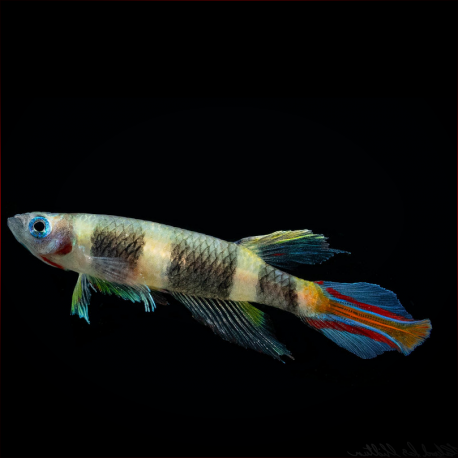More info
Datasheet
| Minimum Tank Size | 40 litres / 10.57 US gallons |
| Maximum Size | 3.5cm / 1.38inches |
| Temperature | 20°C / 68.00°F - 26°C / 78.80°F |
| Hardness | 1.01dgH / 18ppm - 8.01dgH / 143ppm |
| pH | 4.0-7.0 |
General Description
The Clown Killifish (Epiplatys Annulatus) is also known as the 'rocket killifish' or 'banded panchax' and was previously classified under the monotypic genus Pseudepiplatys. This fish species displays variations in color patterns depending on its population, particularly in the unpaired fins. With an adult size of less than 50 mm SL, distinguishing features include the presence of 4 broad, dark transverse bars alternating with yellowish bars from the snout to the caudal-fin.
Aquarium Setup
The Clown Killifish is best suited for a heavily planted aquarium setup or a natural-style arrangement with a sandy substrate, driftwood roots, and branches. Adding dried leaf litter not only enhances the natural ambiance but also provides cover for the fish and promotes the growth of microbe colonies. Avoiding the use of natural peat, the fish thrives under dim lighting conditions and benefits from aquatic plants like Microsorum, Taxiphyllum, Anubias species, as well as floating vegetation such as Ceratopteris species.
Behaviour
Although known to be peaceful with other species, the Clown Killifish may not be an ideal community fish due to its small size and specific requirements. It tends to display more fascinating behavior when kept in groups of at least 8-10 specimens. Good tank mates include small tetras, quiet cyprinids, anabantoids, callichthyids, and loricariids. Thorough research is advised before introducing it to a community tank or pairing it with smaller cichlid species.
Feeding and Diet
In its natural habitat, the Clown Killifish is likely a micropredator, feeding on terrestrial and aquatic invertebrates and zooplankton. In an aquarium, it accepts dried foods but should also be offered small live and frozen foods like Artemia nauplii, Daphnia, and grindal worms daily. Providing a varied diet ensures the fish's nutritional needs are met.
Reproduction & Dimorphism
Breeding the Clown Killifish is relatively easy in a well-decorated aquarium. A separate breeding tank with suitable spawning medium is recommended. The male Clown Killifish is more colorful, develops extended fins, and grows larger than the females. Breeding pairs or groups can lead to the successful hatching of fry, but older fry may prey on younger ones, necessitating separation.
Habitat and Distribution
The Clown Killifish is widely distributed in the coastal lowlands of southern Guinea, Sierra Leone, and northwestern Liberia, inhabiting lowland swamps, slow-moving streams, and small rivers in regions of open savannah and tropical rainforests. The fish thrives among marginal vegetation or aquatic plants in freshwater or slightly brackish conditions. Maintaining stable warm, soft, and acidic water conditions mirrors its natural habitat, where it coexists with other species like Ladigesia roloffi and Scriptaphyosemion chaytori.

